Welcome To The Fun!
Welcome to another great issue of Biodiesel Review! In this issue we'll cover information on making soap out of Biodiesel Glycerin, details on some cool, new Biodiesel production technologies, some new & featured products from our website, plus a cool list of helpful Biodiesel resources to keep your Biodiesel skills in top form.
We'd also like to let you know about an exciting Biodiesel conference that's coming up soon. Typically held in Golden, Colorado each July, the annual Biodiesel Homebrewers Conference is being held this year at American University in beautiful Washington, DC. More details on this great conference can be found at www.collectivebiodiesel.org. Be sure to check out the exciting schedule and register today.
So, with all that out of the way, grab some munchies, sit back, relax and get ready for yet another issue of useful, helpful, and insightful Biodiesel information! Let the fun begin!
|
|
BioPro Drying Oil Correction
|

Springboard Biodiesel found an error in our last newsletter on the technique for drying oil in a BioPro. We wanted to let you know about the error and share the correction. In our Apr. 2009 newsletter, we'd originally stated that you want to heat & mix for 6 hours and then heat & settle for another 18 hours. Here's the corrected steps:1) Heat & Settle Oil for 18-24 hours w/ lid off 2) Drain off any water that's settled out 3) Heat & Stir with lid off for another 6 hours 4) Test for water content 5) If below 0.5%, then process By utilizing the corrected process, you'll be able to reduce the water content in your oil even further. To learn more about the BioPro's, visit our BioPro processor pagesBioPro 150 - Up To 40 Gallons Every 48 HoursBioPro 190 - Up To 50 Gallons Every 48 HoursBioPro 380 - Up To 100 Gallons Every 48 Hours
|
Making Soap From Biodiesel Glycerin
|

If you're like most Biodiesel producers, you probably have a lot of
glycerin laying around....and, like most of us, you'd probably like to
find a way to get rid of it all. One way you can part with all
that glycerin is by converting a portion of it into soap. In fact, one
of our customers has successfully made over 800 bars of soap from the
nasty black stuff and then gone a step further and reacted even more of
the glycerin into liquid soap. In this article will dig into the nitty gritty of what it takes to get started turning your nasty black stuff into bars or jars of this incredible soap! "This Soap Is Amazing!"If
you've never tried using soap made from Biodiesel glycerin, you're
really missing out. The cleaning power it packs is nothing short of
amazing. I've personally seen it take out some of the worst stains out
of kids clothes that commercially bought soap detergents couldn't even
touch. Plus, the moisturizing attributes of glycerin found in this soap are great for the skin. We've had several customers report
back that after using soap made from Biodiesel glycerin their skin felt
softer. In some cases people even have reported calluses just melting
away after using the soap they've made. We don't know if it's a
miracle bar of wonder or just really great soap, but we can vouch for the fact that it
works; and works really well! I personally have been using Biodiesel glycerin
soap in the shower for well over a year now and absolutely love it! I also keep a bottle handy in the laundry room to put on
the kids stained clothes and just last night I even used it as a hand cleaner after I
worked on a neighbors car & got all greasy. I was just flat out
amazed at how well it cleaned my hands. So How Do You Make The Stuff?Believe
it or not, making Biodiesel glycerin based soap is pretty easy. If you can make Biodiesel, making soap will be a breeze! Much of the same processes are used and most people report that it comes very naturally. The Basic Method:This doesn't go into the exact measurements of how it's made (it varies based on the type of soap you're making), but we will give you a good idea of just how simple it can be to make this incredible soap.     1) Get a big pot & heat the glycerin up to boil off the methanol. 2) Dissolve some catalyst (NaOH or KOH) and water in a bowl 3) Add the catalyst/water solution to the heated glycerin while stirring 4) Continue to stir until the mixture gets thick (if making bars)    5) Pour the mixture into the molds and smooth it out 6) Shake the molds back and forth to allow it to settle. 7) Cover the molds and allow the soap to set up overnight    8) After it's set up, remove the soap from the mold and cut it into bars 9) Allow them to cure (2-3 weeks) 10) Package them up & prepare for use It's that easy! You'll be amazed how well it works! How Can It Be Used?Once the soap is made, be prepared to make A LOT MORE of it. Everyone I've ever spoken with reports that once they give a few bars out, the folks that they gave it to come back & want more and more of it. You see, this soap can be used for just about anything you can think of. In liquid form, it makes an excellent moisturizing hand cleaner. Thicken it up a little and it makes a great shower gel and shampoo (seriously, I use it all the time for shampoo!). Get a cheese grater out & grate off a little into the washing machine and be prepared for some of the cleanest clothes you've ever seen. Use it on your hands, arms, & legs to avoid dry, flaky skin (the glycerin in the soap is a natural moisturizer). Add a cap full to a bucket of water and you have floor cleaner. It can also be used in the sink to clean the dishes too. People report back with new uses for the soap they've made all the time. Check out pictures of peoples soap here. " My wife won't ever TOUCH that stuff! It looks gross!" One of the biggest reasons people never get around to making soap from glycerin is because they believe that you can't change the color or the smell of the soap. This is actually incorrect. Available on the market today are several soap making fragrances that can be added to give the soap practically any scent you'd like. The color can also be changed to your liking as well through dyes and bleaching agents. Here's just a few examples of soap of different colors.   From pink to yellow to sparkly soap, I've seen it made into just about every color imaginable and scented in every scent under the sun (my favorite scent is the frankincense and myrrh bars we stock at Christmas time). How Can I Learn More?If you'd like to learn more about how to make soap, you're in luck! One of the most prominent Biodiesel glycerin soap makers decided a couple years ago to write up a guide on how to make soap from Biodiesel glycerin and offer it to the world. We partnered up with him and now have this guide available on our site to purchase. If you'd like to learn more about this guide, click hereThe guide has become so successful that it has now been sold into every state in the US, several international countries, and has even been integrated into some high school and university curriculum. Biodieselers from all over the world have gotten into the soap making fun and have been reporting back on a regular basis with pictures and success stories of the soap they've made. Once you've learned the basics, we also have a section on a popular Biodiesel forum where people have been sharing their variations on the basic recipe. Everything from green liquid hand soap to sparkly colored bars to tips & tricks on how to get your soap to do just about anything under the sun are discussed on a regular basis. Click here to see the discussion forum on soap recipes & more!Can I Sell The Stuff?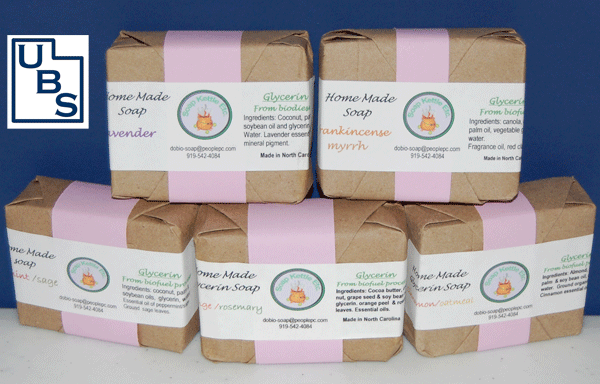 Once people have mastered the art of making the soap, the obvious question is can it be sold. The answer is whole-heartedly YES! There are several people (including us) that sell Biodiesel glycerin soap on a regular basis. All you need to do is figure out a way to package the soap so that it looks nice and appealing and then come up with a way to find a market for it. Some of our customers have created websites where they sell their soap Others have taken their soaps to craft fairs or farmers markets and have had great success. Whether you sell it to your friends & neighbors, market it at fairs & bazaar's or sell it on the web, once people get a hold of some, they always seem to come back for more.  For those that would like to learn from others on how to package, market, and sell the soap, the author of the Soap Making Guide has also put together a really cool guide on how to to get started. The guide includes tips & tricks on how to package, label, and market your soap that you've made. It even includes special information on USDA regulations for soap sold in the United States. Several of our customers have started to use the tips & tricks learned from this guide and have successfully been selling their soap on a regular basis. Click here to read more information on the soap marketing guideWhether you make the soap for yourself or end up selling it to others to share in the fun, we can't think of a better way to responsibly and effectively get rid of the glycerin by-product from the Biodiesel making process. If you're interested in making soap, there are people always available on the discussion forums ready to help you and if you get the guides, the author is great at offering help & support via email. If you'd like to just try a bar of this great soap to see what all the fuss is all about, we have a full line of various bars in different scents that you can purchase right from our website and give it a try. We're pretty sure that once you try it you'll want more and will be just as hooked on the stuff as we are. Plus, it'll help you get rid of that nasty barrel (or barrels) of glycerin you have laying around and hey, it may even earn you bonus points with those around you that "tolerate" your Biodiesel production hobby. We can't think of a better way to get rid of glycerin! Give it a try! You'll be squeaky clean sooner than you think! |
New Biodiesel Technologies
|
 As with everything out there, it seems the art of making Biodiesel changes by the day. In this article we'll highlight some of the newer technologies that have come on the Biodiesel scene that we think are noteworthy. As with everything out there, it seems the art of making Biodiesel changes by the day. In this article we'll highlight some of the newer technologies that have come on the Biodiesel scene that we think are noteworthy.
The BioPro INCOSEP Separator
The first one of note is the newly released Springboard Biodiesel INCOSEP separator. This exciting new product was just released last month and gives BioPro 190 & BioPro 380 owners the ability to separate their glycerin and their wash water in a fraction of the time it normally takes by using something called Induced Coalescence to separate the Biodiesel from the glycerin and water.
I had a chance to visit the factory recently and see one of these in action and was just flat out amazed! The first thing I had a chance to see it work with was watching it separate the glycerin from the Biodiesel. They'd reacted a batch of Biodiesel in a BioPro 190 and were just about ready to let it begin separating. This is when they kicked on the INCOSEP and in a matter of minutes the glycerin had completely separated right before my eyes.
YOU CAN SEE A VIDEO OF AN INCOSEP SEPARATOR IN ACTION HERE
Next came the water washing. They had the BioPro fully loaded with Biodiesel and had just misted in about 10 gallons of water. To really show off how cool the separator was they hit the stir switch and stirred the Biodiesel and water into what looked like a massive emulsified mess. They then turned on the INCOSEP and again, in a matter of minutes the water had completely separated from the Biodiesel. I was just amazed.
The process works extremely well on both separating glycerin and water. It's fast and can give BioPro owners the ability to cut down their Biodiesel production time by up to 58%. Couple it with a new Dry Wash tower and you can knock the normal 48 hour cycle time clear down to 11 hours.
To learn more about the INCOSEP separator, click here
The Spring Pro T76 Dry Wash Towers

In our last newsletter, we briefly mentioned this exciting new product. It's called the SpringPro T76 Dry Wash Tower and it's also from Springboard Biodiesel
The SpringPro T76 tower system has 2 10" towers mounted on a really cool stand. All of the plumbing is already pre-mounted to the towers so that you can easily attach a pump to the towers and be good to go.
The towers can use either cellulose based media, such as Eco2Pure or Ion Exchange Resins such as Thermax, Purolite, or Amberlite. In stock form, the towers come with the leading dry wash combination of Eco2Pure and Thermax already pre-loaded into the towers. The factory even offers a cool option of having the media pre-initialized so that when it gets to you all you have to do is hook the system up to your processor and start dry washing immediately.

Also offered as an option is a really nice pumping package that quickly attaches to a BioPro or any other Biodiesel reactor and allows the towers to pump right from your processor. The pump is rated at a full 20 gallons per hour and can easily dry wash 50 gallons of Biodiesel in under 3 hours.
I watched one of these in action when I was at the factory recently and was really impressed with how simple it was to setup and start using.
To learn more about the SpringPro T76 Dry Wash Towers, click here
Soap Testing
 For the longest time one of the best tests for checking soap levels in Biodiesel has been to use a test called the "Shake-Em Up Test". This test involves adding a sample of Biodiesel and water to a jar, shaking it, and then letting it settle and checking for cloudy water on the bottom. For the longest time one of the best tests for checking soap levels in Biodiesel has been to use a test called the "Shake-Em Up Test". This test involves adding a sample of Biodiesel and water to a jar, shaking it, and then letting it settle and checking for cloudy water on the bottom.
However, this test has always been somewhat faulty because it's possible to have clear water on the bottom and still have elevated soap levels in the Biodiesel.
 A newer and more accurate test has recently been made public on the Biodiesel discussion forums and through Arbor Biofuels Company. A newer and more accurate test has recently been made public on the Biodiesel discussion forums and through Arbor Biofuels Company.
This test works much like a Biodiesel titration works and will give you a much more accurate soap results. If you're planning on moving to a dry washing system, you'll definitely want to look into using this soap testing method.
We now offer a soap test kit that uses this new method for testing soap content. Click here to check out the new test!
We recently shot some video footage of how to perform a soap test using this new method so everyone could see how easy it is to do. Daniel Bowen, from Springboard Biodiesel, was kind enough to do the test and explain the chemistry behind it along the way.
To see the video of how to test using the new method, click here
If you'd like to keep up with all of the fun going on in Biodiesel, be sure to join the Infopop Biodiesel Discussion forum where just about every topic under the sun related to Biodiesel is discussed, rediscussed, hashed out, and then discussed even more.
Here's a link to the forum website: http://www.biodieseldiscussion.com
|
|
New & Featured Products |
We've been adding new products to our line up like crazy these days. Check out some of the cool, new products we've put up in the last couple months as well as some of our more popular water washing products.
LABWARE & LAB CHEMICALS
We've gone a little hog-wild lately adding several new lab testing equipment & chemicals to give you the ability to test your biodiesel with even greater accuracy. Click on any of the images below to learn more.
  
   
CARBOY ACCESSORIES
Recently, we added some cool new accessories to our line of carboys.
 
BIODIESEL WASHING ACCESSORIES
We have a nice line of stainless steel & 3 head washing nozzles that have been extremely popular with Biodieselers. Check them out today!
  

|
Recommended Biodiesel Quality Production Tests
|
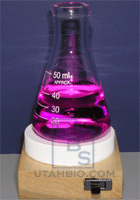
If you've been reading our newsletters, you'll know that I constantly talk about testing before, during, and after Biodiesel is reacted and washed to ensure you have a high quality product. From testing the oil for water and free fatty acid content to testing for soap levels and conversion after it's washed, we believe it's one way to ensure you're producing high quality fuel. To make it even easier to learn about the tests we believe to be of utmost importance to run when making Biodiesel, we've created a new page on our website that highlights each test we recommend, discusses why you might want to consider using the test, and then we go into how to perform the test. We've organized the tests into the order that we believe they're best to run them in during the production process. We've even added links to additional information about each & every test in case you'd like to learn more about them. The page is now available on the top left side of the Utah Biodiesel Supply website under the Biodiesel Basics box. Just look for the Quality Testing link. You can also click here to go directly to the Quality Testing page.We highly recommend spending some time reviewing these tests, getting a good understanding of how each tests works, and then implementing them into your Biodiesel production routine. |
The Emulsion From Hell And How We Broke It!
|
 Recently I had the chance to see one of the worst Biodiesel emulsions I've ever seen or heard of in my life up close & personal. Recently I had the chance to see one of the worst Biodiesel emulsions I've ever seen or heard of in my life up close & personal.
It all started innocently enough. A friend of mine had made a batch of Biodiesel in my BioPro 190 and everything was going well. The glycerin separated off perfect and the oil looked great.
He typically uses oil that's practically new so he's never had to worry about conversions taking, so there was no indication that this batch might be any different than any other.
He started the wash cycle on the BioPro & let it start the process. About 8-10 hours into the process he returned to the BioPro to check up on how it was going and found what I affectionately refer to as "The Emulsion From Hell". He quickly called me and I dropped everything, grabbed my camera, a couple mason jars to sample with & said I'd be right over.
Feeling adventurous, I also filled one of the quart mason jars about 1/3 full of rock salt from my water softener salt bin. I figured, "Hey! It's worth a shot and if it works, it'll beat having to scoop the crap out!"
Check out what I found when I got there....
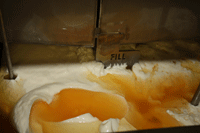 
It had the same consistency and look of a beautiful batch of mayonnaise.
I hit the stir motor to see if there was any liquid at all in there and it just brought more of this nasty mess to the top. If you look close you can see the fill line indicator. That's 50 gallons of absolute glop you're looking at!
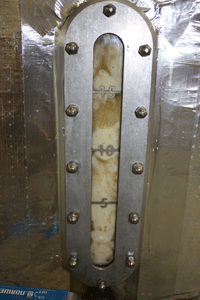 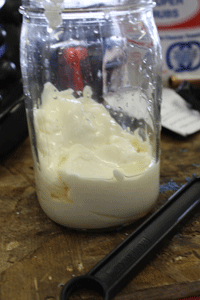 Looking down toward the front of the machine I could see what could only be described as every Biodieseler's worse nightmare staring back at me in the sight glass. Yep! That's an emulsion all right! Looking down toward the front of the machine I could see what could only be described as every Biodieseler's worse nightmare staring back at me in the sight glass. Yep! That's an emulsion all right!
I took one of my mason jars & scooped out a sample and was amazed at the consistency. It really did flow like mayo! Looked about like it too!
So, knowing that if I didn't break this emulsion my friend & I would be scooping out a gelled mass of goop from the machine, I pulled the salt out & mixed some up with some water in another mason jar and dumped it intl the jar you see above, shook it & figured, "Well, here goes nothing!"
What I watched occur before my very eyes just dumbfounded me! The emulsion broke! And it broke REALLY FAST TOO! These pictures were all taken within a 5 minute period. Most of them in under 3 minutes from the time I added the salt water to the emulsified mess.
Check out how fast the emulsion broke! In under 5 minutes my jar of white goo had completely separated! Another 5 minutes went by and the line was razor thin between the layers. I was just flabbergasted!
So, I thought, "Well, let's see what it'll do to the rest of the emulsion!" So, I took the rest of the salt I had in the jar (now maybe 1/4 full of rock salt), filled it with water, put a lid on it & shook it until it was dissolved. Then I just dumped it straight into the BioPro. Mind you, just one measly quart jar of salt water was now dumped into 50+ gallons of thick, emulsified goo. I thought it MIGHT put a dent in it, but I didn't want to get my hopes up too high. Well, believe it or not, that measly quart jar broke the whole batch!
I poured it into the main opening, watched it start to melt the top layer away so I kicked on the stir motor & watched as globs of goo came floating up to the top (it looked a lot like mixing mashed potatoes in a monstrous mixer). Then right before my eyes the emulsion started breaking...and I mean FAST!!! Take a look at the pictures below & you can see just how fast that little quart jar of salt water broke the emulsion.

If I wasn't there to see it myself, I never would've believed that it could have broken the emulsion as fast as it did. It was nothing short of amazing.
So, if you ever find yourself with an absolute mess of an emulsion, instead of grabbing the shovel to scoop it out, give a little salt water a try. You may just get to watch your own little miracle in action too!
Long live salt water! The wonder cure for the nastiest emulsions out there!
|
Helpful Biodiesel Resources
|
 One of the great ways to keep up on your Biodiesel production skills is by learning from all the great Biodiesel resources available today. One of the great ways to keep up on your Biodiesel production skills is by learning from all the great Biodiesel resources available today.
Biodiesel Smarter Magazine
One of our favorite publications that follows this mantra is Biodiesel Smarter Magazine. Started a couple years ago by Frankie Abralind, this publication has grown into one of the best publications available for keeping on top of all the latest developments involved with this great renewable resource.
From new brewing techniques to the latest in government policy changes to really cool case studies on Biodiesel production setups, this magazine covers it all. To learn more about Biodiesel Smarter Magazine, click here
 The Collaborative Biodiesel Tutorial The Collaborative Biodiesel Tutorial
This tutorial website was written by people from all over the world that love Biodiesel and want to share what they've learned. It's well organized, easy to read through, and contains some of the best information available on the web for making Biodiesel as well as great information on equipment plans, advanced production techniques, and more! Click here to visit the tutorial website The Biodiesel Collective Conference Site The Biodiesel Collective Conference SiteWith presentations from the last 3 years of the Collaborative Biodiesel Conference, this site is jam packed with some of the most amazing information out there! From methanol recovery to running a Gas Chromatograph, to heating Biodiesel with solar power to regulatory issues with Biodiesel, this one has got it covered! Click here to visit the Biodiesel Collective site!The next conference is July 31 - Aug. 2nd. Click here for more details The National Biodiesel Board Website The National Biodiesel Board WebsiteThe National Biodiesel Board is the Biodiesel trade industry organization. Their site is absolutely chalked full of useful information. From regulations on selling Biodiesel to tax incentives to the latest on the ASTM standards for Biodiesel, these guy's have it all. If you want to keep abreast of the commercial industry, this is THE place to do it. Click here to visit the NBB website Utah Biodiesel Supply YouTube Channel Utah Biodiesel Supply YouTube ChannelWe've started a YouTube channel where we've started posting helpful tutorial videos on Biodiesel. These include everything from titrating oil to how to cleanse Ion Exchange Dry Wash media properly with methanol. Subscribe today & be notified of the latest videos we publish! Click here to visit today! Utah Biodiesel Supply Website Utah Biodiesel Supply WebsiteThis is our main site for our online store. We keep it packed with all the greatest products, tutorials, kits, resources, testing supplies, and just about everything else you can think of that might be tied to making Biodiesel. Since 2005 we've steadily grown the site with new information and products nearly every month we've been in business. Click here to visit Utah Biodiesel SupplyThere are several more resources available to Biodieselers on the web with more seeming to pop up every day. If you'd like to see a more comprehensive list of the one's we're aware of, visit our links page today |
|
|
Thanks for spending a few minutes reading through our latest issue of Biodiesel Review. We hope you've found a few new tips and ideas for your Biodiesel adventures! If you have suggestions for future articles, by all means, sent them in. We keep a running list and refer to it every time we publish a new issue.
Happy Brewing!
Graydon Blair
Biodiesel Review
|
|
|
2009 Biodiesel Conference
|
 |
The Annual Biodiesel Conference is coming!
July 31-Aug 2nd
American University
Washington, DC
Register Today!
|
|
|